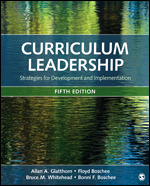Curriculum Leadership
Strategies for Development and Implementation
- Allan A. Glatthorn
- Floyd Boschee - Professor Emeritus, The University of South Dakota
- Bruce M. Whitehead - Retired School Principal, Missoula School District #4, University of Montana, USA
- Bonni F. Boschee - Assistant Professor of Humanities, Beacon College
Curriculum Leadership: Strategies for Development and Implementation helps current and aspiring administrators, teachers, and curriculum directors successfully restructure, enhance, and implement school K–12 curriculum. This foundational book highlights 21st century educational ideas and advocacy, while also remaining focused on tried and true strategies for meeting state and national standards in today’s diverse classrooms.
Featuring an array of new scholars, researchers, and case studies, the Fifth Edition: centers on the importance of teachers and teacher-leaders in the area of curriculum development; promotes the crucial role of special education and its contribution to the overall curriculum development process; and includes a renewed emphasis on concurrent learning and creating stimulating online discussions.
With the support of this thought-provoking and extensively researched text, readers will develop a working and thorough foundation of curriculum to effectively implement in the classrooms of the future.
Supplements
Password-protected Instructor Resources include the following:
- A Microsoft® Word test bank is available containing multiple choice, true/false, short answer, and essay questions for each chapter. The test bank provides a diverse range of pre-written options as well as the opportunity for editing any question and/or inserting personalized questions to assess students’ progress and understanding.
- Editable, chapter-specific Microsoft® PowerPoint® slides offer complete flexibility in easily creating a multimedia presentation for courses, and highlight essential content and features.
- Exclusive access to various full-text SAGE journal articles that support and expand on the concepts presented in the chapters. Combine cutting-edge academic journal scholarship with the topics in the course for a robust classroom experience.
- Lecture notes summarize key concepts on a chapter-by-chapter basis to help with preparation for lectures and class discussions.
- Sample course syllabi for semester and quarter courses provide suggested models for use when creating the syllabi.
- Lively and stimulating chapter activities that can be used in class to reinforce active learning. The activities apply to individual or group projects.
- Web exercises direct readers to relevant websites to extend and reinforce learning and encourage further research on important chapter topics.
- All graphics from the text, including maps, tables, and figures, are available to create consistent formats for class presentations.
Curriculum Leadership offers practical advice and a nice history of curriculum in the US. I find this book ideal for my upcoming Curriculum Models course in Educational Administration.
This textbook is a comprehensive resource with the introduction to Curriculum. The resource captures all of the important components of Curriculum for students in education.
Excellent and complete. Great for my post graduate hybrid course. Good questions and exercises
The organization and content of the text are well suited to the objectives of the course (master's level) in which it is intended for use. It provides enough foundational knowledge on the key topics to allow for easy supplementing using available research and peer-reviewed articles. Readability is good and concepts are explained clearly.
